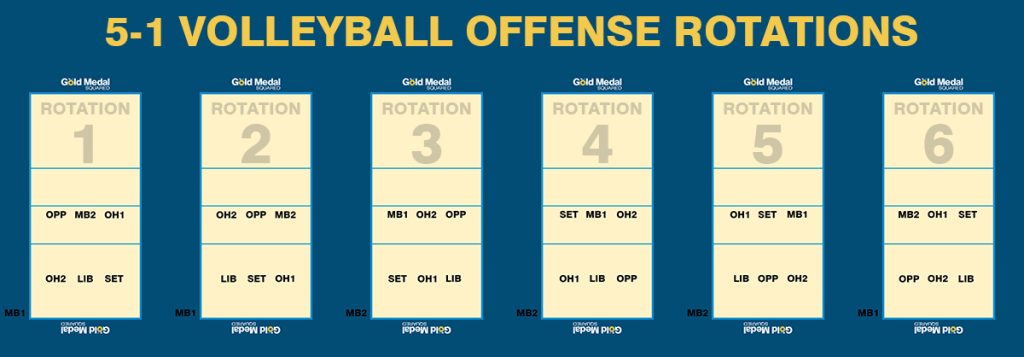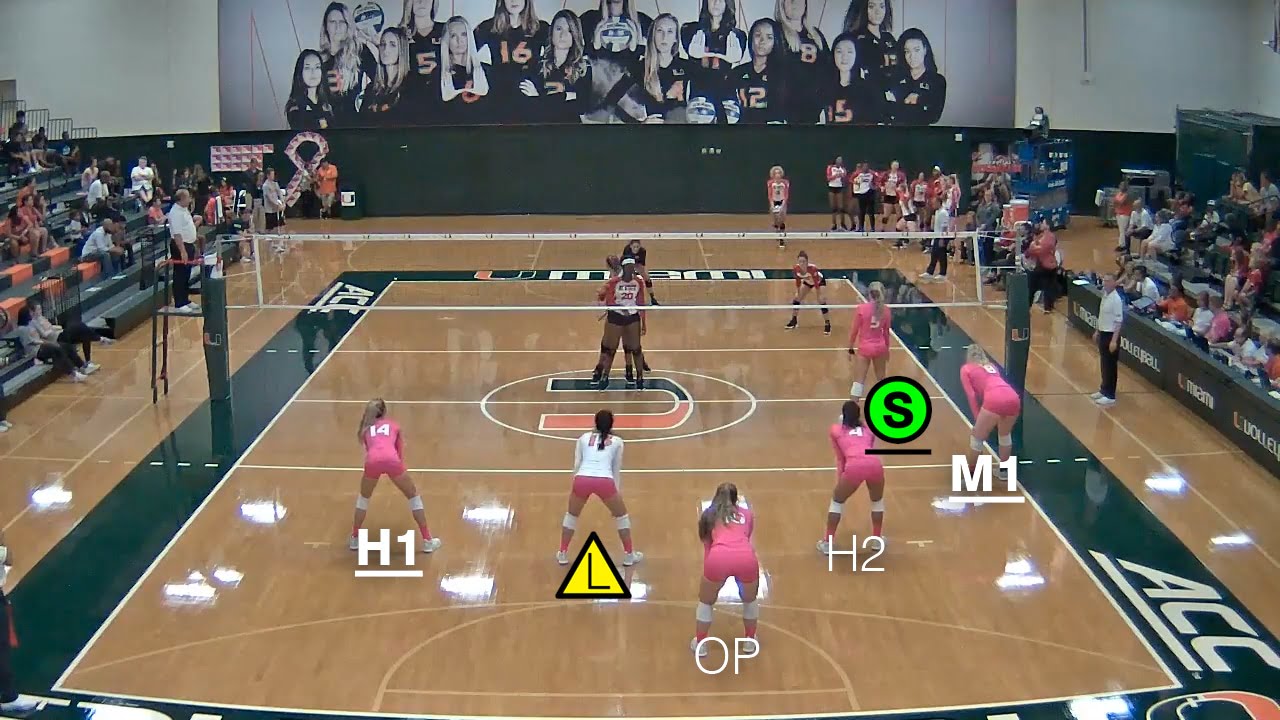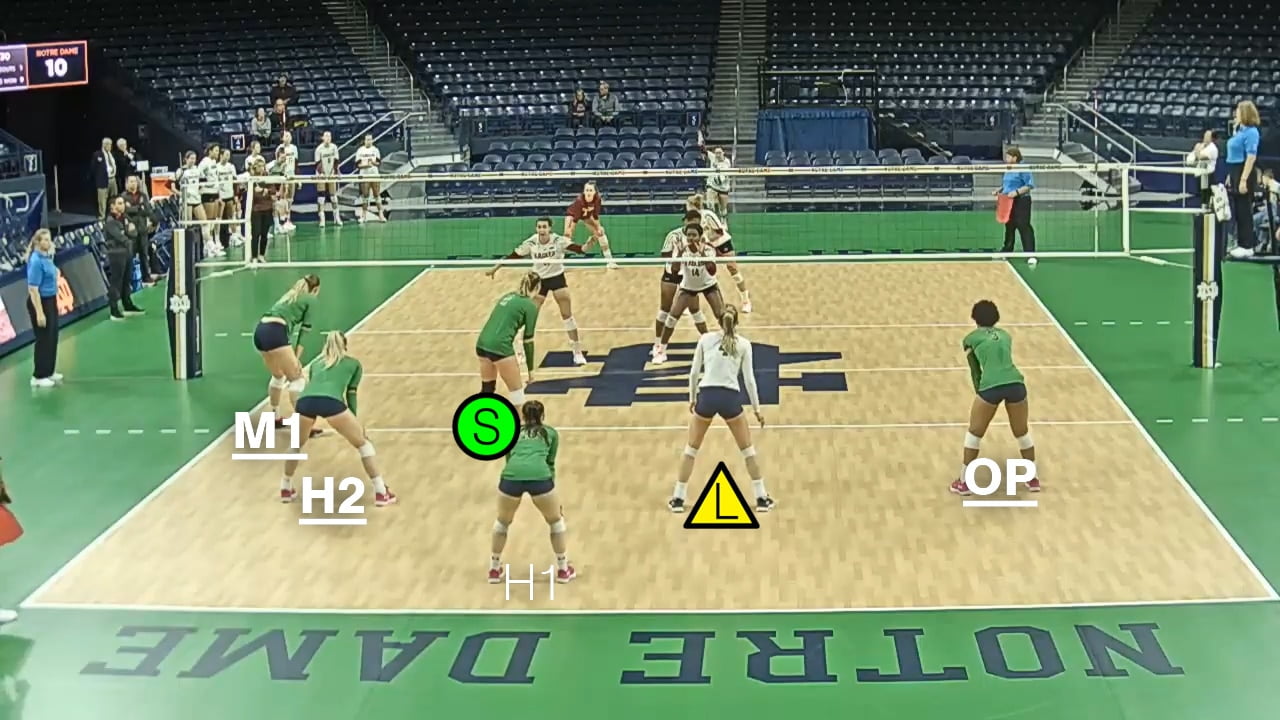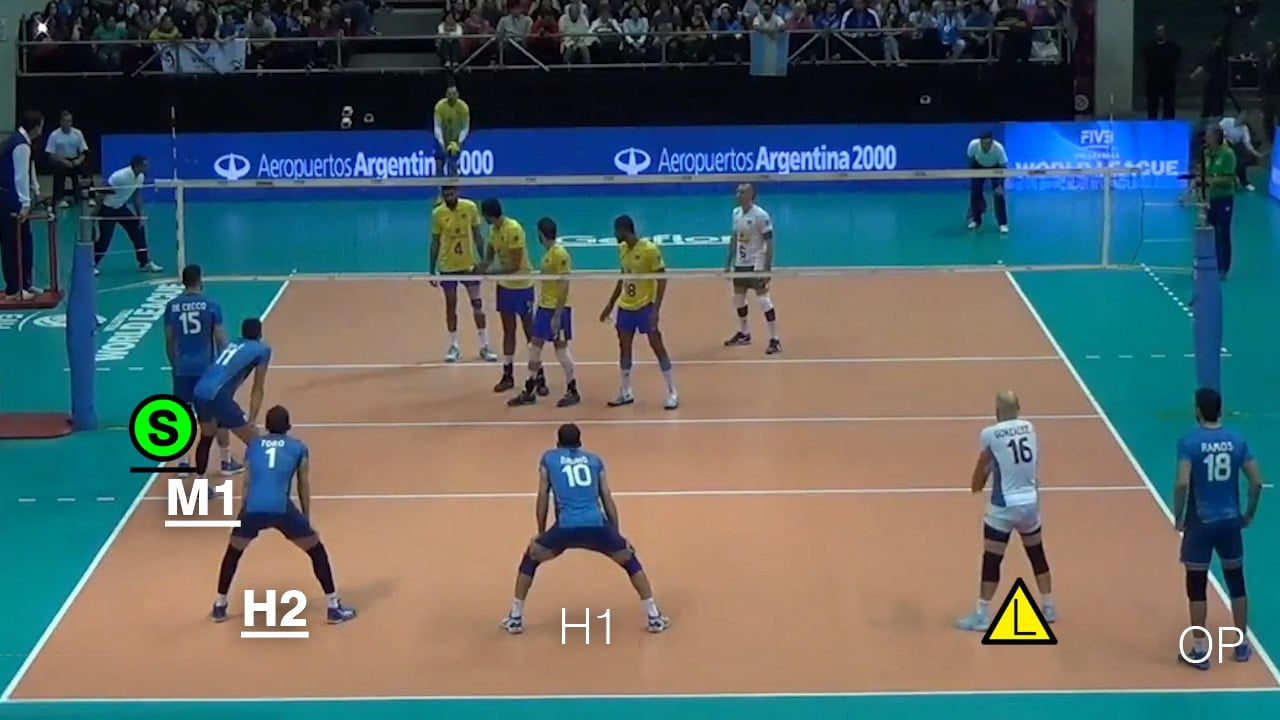THE 5-1 VOLLEYBALL ROTATION - AN INTRODUCTION
One of the most common offensive systems used by volleyball teams worldwide is the 5-1 system. Part of the reason for this is that under the Fédération Internationale de Volleyball (FIVB) rules, teams are limited to 6 substitutions per set and a player who has been subbed in and then out during a set is unable to return to the court during that set. With a little effort, learning 5-1 offensive rotations is fairly simple.
In the USA, Women’s NCAA and Junior Volleyball teams do not follow the FIVB substitution rules but benefit from amended rules that allow for up to 12 substitutions per set. This allows players to continually roll in and roll out during each set.
In leagues that follow the FIVB substitution rule, coaches need to be more tactical with their substitutions meaning that the 6 players who take the court at the start of the game need to be able to play effectively in all 6 rotations.
To this day, it still amazes me that so many substitutions are allowed in NCAA Women’s Volleyball, and I am constantly seeing new advantages and disadvantages of this rule in areas such as player development and tactical roles. That is one of the greatest aspects of coaching: you can always learn something new if you are willing to be open-minded. I still haven’t decided where I stand on the idea of having more substitutions!
Before I get completely off topic and get really animated about other aspects of Volleyball (I find I can talk for hours on the intricacies of the sport), let’s get back to the matter at hand, what is the 5-1 volleyball rotation system?
What is the 5-1 Volleyball Rotation?
The 5-1 system gives each player a very defined role within the team. Five of the starting six players will be offensive players in the system, and the sixth will be a permanent setter. No matter where the player is on the court (Front or Back Court) their offensive role will remain the same. There will be a designated opposite, two outside attackers, and two middle blockers that make up the team’s attacking options.
There is no need for any substitutions to take place to make this system function.
In rotation 1, the setter will line up in zone 1, with the opposite starting in position 4. Zones 3 and 6 will be occupied by the two middle blockers, and the two outside attackers will start in zones 2 and 5. This means that the team will start the game with three front-court attackers and one back-court attacker (through zone 6, commonly called a ‘Pipe’ attack).
When the setter rotates into the frontcourt in rotation 4 there will only be two front Court attackers available, but the team will now have two backcourt attacking options available with the back row opposite and back row outside hitter.
5-1 System Summary:
- The team consists of 5 attackers and 1 setter for offensive situations.
- One of the attackers may be temporarily replaced by the libero whilst in the backcourt.
- Every player has a very defined role.
- The players will fulfill their role regardless of their position on the court.
- All players may remain on the court for all rotations without any substitutions required.

Advantages of the 5-1 Offensive System:
With this system, all of the players have clearly defined roles and can understand what their job for the team is. They are able to focus on only their required skillset in training, perform more repetitions in these skills and develop consistency in their play. This in turn helps them to feel connected to the team goals. If a player’s role within a team is constantly chopping and changing it can affect some players in terms of confidence or knowing what they are expected to do.
If a team has a setter who is able to play all the way around the court, then this can be the ideal system to run. It allows setters and attackers to form and maintain strong connections and avoid the potential of stalling momentum when players have to switch roles or substitutions are introduced.
One typical use of substitutions with this system is what is known as the “double-sub”, which is used when the setter rotates into the frontcourt and the opposite onto backcourt. A replacement setter is subbed on for the opposite in position 1 and a replacement opposite is subbed on for the setter in position 4. This form of substitution is commonly used towards the end of a tight set to strengthen the block and provide 3 front court attackers. However, there are times at all levels of volleyball when this double substitution is used, and the team then concede a run of points. Sometimes, when a team has a strong setter, it makes sense to use this athlete in all rotations rather than risk a momentum slide and a potential moment of panic within your team.
From the opposite’s perspective, this system allows them to maintain an attacking rhythm. They will not be coming in and out of the game but instead might get more attacking repetitions from the backcourt. The timing of the ball might be slightly different but playing without a break can mean that the athlete stays connected with the game and “in rhythm” with the setter. It also provides the opportunity to get a greater understanding of transferring body weight through the ball when attacking from the backcourt. When this understanding transfers into their frontcourt attack, the power output of the athlete will usually increase, and then other mental attributes such as their confidence will grow.
With the opposite in the backcourt, the number of available back-court attacks will increase. As back-court attacks require different block timing, the opposition blockers will have to stay aware of the rotation the attacking team is in and make sure they are timing their blocks correctly. If they don’t then the block will be poorly formed and give the attacker, the opportunity to wipe off or tool the block. Even though the attacker is backcourt, it is still possible to run a faster tempo ball, and depending on the combinations run with the pipe and middle attacker, a team can maintain a scenario where there are four attacking options spaced out along the net.
This system also brings the “slide” attack into play, where the middle attacker passes behind the frontcourt setter to attack from zone 2. A slide attack plays further havoc with opposition blockers because there are more moving offensive components that require tracking. Smart setters will be able to use attackers as decoys to create more space for the attacker that is scoring points, whilst still keeping the opposing blockers “honest” (seeing the other attackers as threats). The slide also requires a different timing for blockers, so again more stress is put on the opposition’s blocking unit, which can be used to the attacking team’s advantage.
Playing with this system also allows a team to have more specialized roles within position groups. For three rotations there will only be two front-court attackers. In this situation you want both players to be strong attackers. If a team has a weaker passer whose strength is attacking, this system gives the coach the opportunity to use this player in the frontcourt with the setter and allow them to focus more on attacking. A team might also have a middle blocker who is a strong attacker and has the ability to run a slide attack so they would also play this player close to the setter. There is the potential within this system to allow players to focus more on their strong skills and place less emphasis on weaker aspects of their game.
Advantages Summary:
- The same setter plays all 6 rotations – strong connections maintained with all players.
- Players staying on court develops consistency.
- The opposite attacker plays frontcourt and backcourt so stays in rhythm.
- Opportunity to add multiple front & back court attacks to the team’s offense.
- The system allows for specialized roles within position groups.
- Provides the opportunity to run a slide attack.
Disadvantages of the 5-1 Offensive System:
One of the lesser-developed areas of a setter’s game can be the skill of blocking. When coaches are limited with practice times, something has to give way for setting repetitions, and in many cases, this can be blocking repetitions. This means that some setters will have a weakness with blocking that other teams will look to exploit, especially if that team is outside attacker dominant. When considering this system, it is important to find a balance; is the team performing well enough defensively to give themselves opportunities to attack, or are they just relying on high side out percentages?
There is also more offensive output expected from the outside attacker. With only 2 attackers in the frontcourt, the release ball in difficult situations is usually to the frontcourt outside, meaning that this athlete has to be confident in “Out of System” situations. There is also an increased chance of the opposing blockers stacking if a team runs its middle attackers predominantly in front of the setter, which has the effect of bunching up attackers into a more compact zone. What might help avoid this situation is utilizing a slide attack, a faster backcourt opposite set, or bringing the pipe attack in behind the setter. If your outside is a strong attacker but is repeatedly getting blocked, their strength is being neutralized, so you might have to consider how that may be affecting other areas of their game?
In women’s volleyball in particular, the system that many teams typically employ is the ‘6-2 with substitutions.’ This means that there are 9 players who are consistently playing and being involved in the game (including the libero), plus any defensive specialist substitutes. Choosing to run a 5-1 system instead means having to also consider the roles of the bench players, and making sure that they stay connected to the team through these roles. Running this system might mean they have fewer opportunities to get court time but they still have important roles to play for the team. Sometimes as coaches it can be too easy to focus on the technical aspects of volleyball, but just as important is the players’ mental wellbeing and their feelings of being connected to the team.
Disadvantages Summary:
- Blocking is one skill setters get fewer repetitions at – does your defense suffer?
- When the setter is in the frontcourt, the frontcourt outside needs to be more offensive both in and out of system.
- Important for a coach to understand how to then use the whole squad effectively and explain to each player their role within the team.
What type of team will benefit from running the 5-1 offensive system in volleyball?
If a team has one solid setter that can locate the ball at a higher level than other members of the team, then it would make sense to run a 5-1 (yes, even if that setter is short). Particularly in Men’s Volleyball where there is more emphasis on high First Ball Side Out (FBSO) percentages, teams want to ensure that their offense runs as smoothly as possible and their setter is one of the key facilitators of this.
If a team has an outside attacker who is not necessarily the best passer but has a great arm swing and can score points in difficult situations, then this system allows a coach to tailor their role and give them more responsibility using their strengths in the attack. Some teams will have their secondary outside attacker as a strong passer which can then relieve some of the stress on the more attack-focused outside and allow them to perform rather than allowing their passing performance to dictate their play.
If a team is struggling to maintain a rhythm, or consistently drops runs of points, then it might be worth asking what role all of the substitutions are playing in this disjointedness. When players spend more time on the court together there is a greater chance that they will be able to work through any problems together and find solutions. If there are continual changes then communication becomes even more vital so it might be worth considering letting six players play as much as possible together and form strong connections, and then find ways to implement other systems if you feel it will then add to your game plan?
If you have a good slide hitter and/or good back row attackers, the need to have three front row attackers on the floor at the same time is lessoned because your team will be able to score kills with the combination of two front row attackers and the back row attackers.
If your setter is an offensive threat and can score kills as a front-row attacker with setter dumps, this is a great system for your team.
Team Style Summary:
- Teams with a single strong setter.
- Teams with an outside attacker that can attack well but maybe not pass amazingly.
- Teams struggling with connection or rhythm disruption – more time on court together.
- Teams with a good slide hitter.
- Teams with a good back row attacker
- Teams with a setter than can score points with setter dumps.
Further your knowledge:
See in the above videos how the USA women's national team runs a 5-1 offense. Their roster includes all the important aspects of a team that succeeds with this system: A strong setter that can play all six rotations, good slide hitters, and good back row attackers.
Here at Gold Medal Squared, we want to share what we have learned. Pooling together resources from different people, experiences from both the coaching and playing aspects of volleyball, we have created a resource that aims to help coaches expand their Volleyball Knowledge and have the opportunity to develop smarter and more effective volleyball athletes. This resource is our GMS+ platform that contains not only system breakdowns, but drill suggestions, practice plans from esteemed coaches, statistical breakdowns. If you haven’t already, head on over to the GMS website and find out more about the GMS+ platform and how it might be able to take your team to new heights
Want To Learn About More Common Offensive Systems?
5-1 Volleyball Rotations Explained (this article)
6-2 Volleyball Rotations Explained
4-2 Volleyball Rotations Explained
6-6 Volleyball Rotations Explained
6-3 Volleyball Rotations Explained







